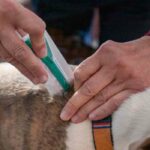
If you’re frustrated by the lack of results from your dog’s flea treatment, you’re not alone. There are several reasons why flea treatments may not be effective, and it’s essential to understand them to ensure your pet’s well-being.
First, it’s important to note that not all flea treatments work the same way. Some products may be more effective than others, depending on your pet’s individual needs and the severity of the flea infestation. That said, even the most effective treatments can fail if there are underlying issues at play.
Key Takeaways:
- Different flea treatments work differently, and some may be more effective than others.
- Flea treatments may fail due to underlying issues such as flea resistance, poor application techniques, environmental factors, or underlying health conditions.
- It’s crucial to understand the potential reasons why flea treatments may not be working and take steps to address them to ensure your pet’s well-being.
Understanding Flea Resistance
It is not uncommon for dog owners to experience ineffective flea treatment despite using recommended products. In such cases, flea resistance could be the culprit. Flea resistance is when certain types of fleas develop an immunity or resistance to certain types of flea treatment over time.
Fleas reproduce rapidly and some may develop a resistant gene to common flea treatments, making them difficult to eradicate. Flea resistance can occur due to repeated use of the same type of flea treatment or exposure to residual flea treatments. It is essential to rotate flea treatments to minimize the risk of flea resistance.
Effective flea control depends on using the right treatment at the right time and following instructions carefully. Most flea treatments work by attacking the flea’s nervous system, leading to paralysis and eventually death. However, fleas can adapt to survive these chemicals, leading to ineffective flea treatment.
Factors That Contribute to Flea Resistance
Several factors contribute to flea resistance, including:
- Repeated use of the same flea treatment
- Exposure to residual flea treatments
- Environmental factors such as temperature, humidity, and light
- Flea species and susceptibility to certain treatments
It’s essential to consult your veterinarian to determine which flea treatment is most effective for your pet’s specific needs.
If you suspect that your flea treatment is ineffective due to flea resistance, speak to your veterinarian. They may recommend an alternative flea treatment or combination of treatments to manage flea resistance in your pet’s environment.
Incorrect Application Techniques
One of the most common reasons why flea treatments may not be working is incorrect application techniques. It’s important to follow the instructions provided by the manufacturer carefully to ensure that the treatment is applied correctly.
Some pet owners make the mistake of not applying enough treatment or failing to apply it in the right places. Others may apply too much product, which can be harmful to their dog’s health.
To apply flea treatments correctly, start by reading the instructions carefully. Use the recommended amount of product and apply it directly to your dog’s skin, not just on their coat. Be sure to cover all areas, including hard-to-reach places like the neck and tail.
When applying topical flea treatments, it’s important to part your dog’s fur and apply the product directly to their skin. With spot-on treatments, apply the product in a straight line from the base of your dog’s skull to the shoulder blades.
Finally, be sure to wash your hands thoroughly after applying flea treatments and keep your dog away from other pets until the product has dried.
Environmental Factors
If your dog’s flea treatment isn’t working, environmental factors could be to blame. Fleas can survive in your pet’s living environment, including carpets, bedding, and furniture, making it crucial to treat your home as well as your pet.
To combat a flea infested environment, begin by vacuuming all areas where your pet spends time, including floors, furniture, and pet bedding. After vacuuming, dispose of the vacuum bag or clean the canister to prevent fleas from re-infesting your home.
Wash all pet bedding and any other washable items your pet regularly uses in hot water to kill fleas and their eggs. Consider using a flea spray or fogger to treat carpets, furniture, and other non-washable items. Be sure to follow all instructions carefully and keep your pet out of the treated area until it is safe for them to return.
Preventing flea infestations in your home is key to ensuring the effectiveness of your pet’s flea treatment. Regularly grooming your pet can help you spot fleas early and prevent them from becoming a problem. Additionally, using flea preventatives on a regular basis can help keep fleas at bay and prevent future infestations.
Allergic Reactions and Underlying Health Issues
If your dog’s flea treatment is not working, it could be due to allergies or underlying health issues. One of the most common allergies in dogs is flea allergy dermatitis (FAD), which is caused by an allergic reaction to flea saliva. When a flea bites your dog, its saliva is injected into the skin, causing intense itching and discomfort. Dogs with FAD may scratch, lick, and bite their skin, which can lead to infections and further skin damage.
It’s essential to consult with your veterinarian if you suspect your dog has FAD or other allergies. Your vet can perform tests to determine the cause of your dog’s symptoms and prescribe appropriate treatment. In some cases, your vet may recommend a different type of flea treatment or additional medication to manage your dog’s allergies.
Underlying health conditions can also contribute to the ineffectiveness of flea treatments. For example, if your dog has a weakened immune system or a hormonal imbalance, they may be more susceptible to flea infestations. In some cases, flea infestations can also be a sign of an underlying health condition, such as allergies, thyroid problems, or Cushing’s disease.
Again, it’s essential to consult with your veterinarian if you suspect your dog has any underlying health issues. Your vet can perform tests to diagnose any conditions and recommend appropriate treatment. By addressing any underlying health issues, you can improve the effectiveness of your dog’s flea treatment and ensure their overall well-being.
Conclusion
In conclusion, as a professional copywriting journalist, I have explored various potential reasons why your dog’s flea treatment may not be working effectively. It is essential to understand flea resistance, the correct application of flea treatments, environmental factors, and underlying health issues. Neglecting any of these factors can contribute to the ineffectiveness of flea treatments.
By taking the time to understand and address these factors, you can improve the effectiveness of your dog’s flea treatment and prevent flea infestations. If you suspect your dog has an underlying health issue, it is essential to consult with a veterinarian. Additionally, regularly washing your dog’s bedding and vacuuming your home can help reduce the risk of flea infestations in your home.
Remember, flea prevention is crucial for your dog’s health and well-being. By following the advice provided and staying vigilant, you can help keep your pet flea-free and comfortable all year round.
FAQ
Q: Why is my dog’s flea treatment not working?
A: There can be several reasons why your dog’s flea treatment may not be working as expected. It could be due to flea resistance, incorrect application techniques, environmental factors, or underlying health issues. Let’s explore these factors in detail.
Q: What is flea resistance?
A: Flea resistance refers to the ability of fleas to develop a tolerance or resistance to certain treatments over time. This means that some fleas may not be affected by the flea treatment you are using, rendering it ineffective. Flea resistance can occur due to genetic factors or improper use of treatments.
Q: How can I apply flea treatment correctly?
A: Proper application of flea treatment is essential for its effectiveness. Common mistakes include not following the instructions, using expired products, or applying the treatment incorrectly. It is important to read the instructions carefully, use the right dosage for your dog’s weight, and apply the treatment directly to the skin as instructed.
Q: What environmental factors can affect flea treatment?
A: Fleas can persist in your dog’s living environment, including your home and yard. If the environment is not treated alongside your dog, reinfestation can occur even after using flea treatments. It is important to regularly clean and vacuum your home, wash your dog’s bedding, and use flea treatments specifically designed for the environment.
Q: Can allergies or underlying health issues affect the effectiveness of flea treatment?
A: Yes, allergies and underlying health issues can contribute to the ineffectiveness of flea treatment. Dogs with allergies, such as flea allergy dermatitis, may experience severe reactions even if the fleas are killed. Additionally, underlying health conditions can weaken a dog’s immune system, making them more susceptible to flea infestations. Consulting with a veterinarian is important if you suspect your dog has health issues affecting the effectiveness of flea treatments.
- Does Flea Treatment Kill Lice? - September 8, 2023
- Does Flea Treatment Kill Mites? - September 8, 2023
- How to Put Flea Treatment on a Dog? - September 8, 2023






